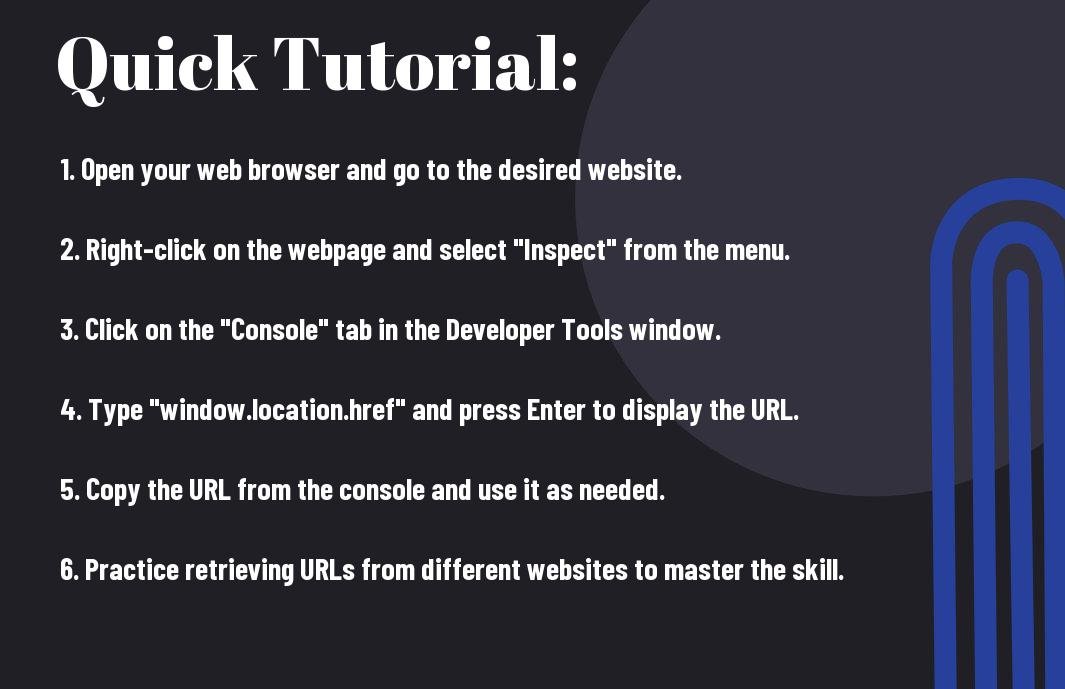As a web developer, understanding how to retrieve the current URL in JavaScript is crucial to your success. Whether you’re looking to track user behavior on your website or customize the user experience, having the ability to access the current URL is essential. In this tutorial, I will guide you through the process of getting the current URL using JavaScript’s built-in methods and provide examples of how you can utilize this skill in your web development projects. By the end of this post, you will have mastered this important technique and be able to implement it confidently in your work.
Key Takeaways:
- Window.location is the key JavaScript object that contains information about the current URL of the web page.
- Accessing the href property of the location object allows developers to retrieve the complete URL of the web page.
- Understanding how to get the current URL in JavaScript is crucial for web developers as it enables them to dynamically generate content and interact with the user based on the page URL.
- Manipulating the parameters and fragments of the URL using JavaScript’s URLSearchParams and string manipulation techniques can enhance the user experience and functionality of a web application.
- Being proficient in retrieving the current URL in JavaScript is a fundamental skill for web developers, as it allows for the creation of dynamic and interactive web applications that can adapt to user input and behavior.
Understanding the Document Object Model (DOM)
Before delving into how to retrieve the current URL in JavaScript, it’s important to have a basic understanding of the Document Object Model (DOM). The DOM represents the structure of a web page as a tree of objects, where each object corresponds to a part of the web page. In the DOM, everything in a web page is a node: the document itself, the HTML elements, and the attributes within those elements. Understanding the DOM is crucial for web developers as it allows for dynamic access and manipulation of the content, structure, and style of a web page.
Accessing the current URL using window.location
When it comes to accessing the current URL in JavaScript, the window.location object plays a crucial role. It provides information about the current URL of the document, including the protocol, host, port, pathname, search, and hash of the URL. By accessing the properties of window.location, you can retrieve and manipulate different parts of the URL to suit your needs, such as extracting parameters or modifying the URL dynamically based on user interactions.
Retrieving the current URL parameters
One common task in web development is retrieving the parameters from the current URL. These parameters can be part of the URL query string and are typically used to pass data between different pages or to specify the state of the page. By leveraging the properties of window.location, such as search and URLSearchParams, you can effectively extract and manipulate the parameters from the current URL, allowing you to customize the behavior of your web application based on the provided parameters.
Using the location object to get the current URL
Some of the most essential functions for web developers involve manipulating the current URL of a webpage. By utilizing the location object in JavaScript, I can easily access and modify the current URL. This is a must-have skill for web developers as it allows you to create dynamic and interactive web pages.
Obtaining the full URL
When it comes to obtaining the full URL of the current webpage, I can simply access the href property of the location object. This will return the complete URL, including the protocol, domain, port, path, and the fragment identifier. By using location.href, I can easily capture and manipulate the full URL in my JavaScript code.
Extracting specific parts of the URL
Another important aspect of getting the current URL is extracting specific parts of it. I can use the properties of the location object such as hostname, pathname, and search to extract the domain, path, and query parameters from the URL, respectively. This allows me to access and manipulate specific parts of the URL according to my requirements.
Implementing current URL retrieval in real-world scenarios
Keep in mind that getting the current URL can be crucial for various real-world scenarios as a web developer. For example, you may need to retrieve the URL to track user behavior, customize content based on the page URL, or debug an issue that’s specific to a certain URL. In any case, having the ability to retrieve the current URL using JavaScript is an essential skill that will come in handy in numerous situations.
Updating the URL in response to user actions
When it comes to updating the URL in response to user actions, you can use the history.pushState() method in JavaScript. This method allows you to update the URL without causing the page to refresh, providing a seamless user experience. By leveraging this method, you can update the URL based on user interactions such as form submissions, filtering options, or page scrolling, without disrupting the overall page functionality.
Handling dynamic URL changes
Dynamic URL changes can occur in various scenarios, such as when implementing a single-page application or utilizing AJAX to load content dynamically. In such cases, it’s important to keep track of URL changes and ensure that the page state remains in sync with the URL. Utilizing event listeners for URL changes and properly managing the state of your application can help you handle dynamic URL changes seamlessly, providing a smooth and responsive user experience.

Conclusion
Drawing together all the essential elements of JavaScript, understanding how to retrieve the current URL in JavaScript is an indispensable skill for any web developer. Whether you are building a complex web application or a simple website, being able to access and manipulate the URL in JavaScript is crucial for dynamic content and user experience. By mastering this skill, you will have the capability to create more interactive and engaging web applications that can adapt to and interact with the current URL, providing a personalized and seamless experience for your users. So, make sure to add this skill to your arsenal as a web developer, and you will be well on your way to enhancing your coding capabilities and creating standout web projects.
FAQ
Q: What is the importance of getting the current URL in JavaScript?
A: Obtaining the current URL in JavaScript is crucial for web developers as it allows for dynamic content generation, tracking user actions, and creating personalized user experiences.
Q: How can I get the current URL in JavaScript?
A: You can obtain the current URL in JavaScript by using the window.location object, which provides access to the current page’s URL and allows you to extract different parts of it, such as the protocol, hostname, path, and query parameters.
Q: What are some practical use cases for obtaining the current URL in JavaScript?
A: Practical use cases for getting the current URL in JavaScript include implementing navigation menus based on the current page, tracking user behavior for analytics purposes, dynamically loading content based on the URL parameters, and creating shareable links with pre-filled information.
Q: Can I manipulate the current URL using JavaScript?
A: Yes, you can manipulate the current URL using JavaScript by modifying the properties of the window.location object, such as assigning a new URL to the href property, adding or modifying query parameters, or even redirecting the user to a different page.
Q: Are there any security considerations when working with the current URL in JavaScript?
A: When working with the current URL in JavaScript, it’s important to be mindful of potential security vulnerabilities, such as cross-site scripting (XSS) attacks if the URL parameters are not properly sanitized and validated. Always validate and sanitize any user input derived from the URL to prevent security risks.

